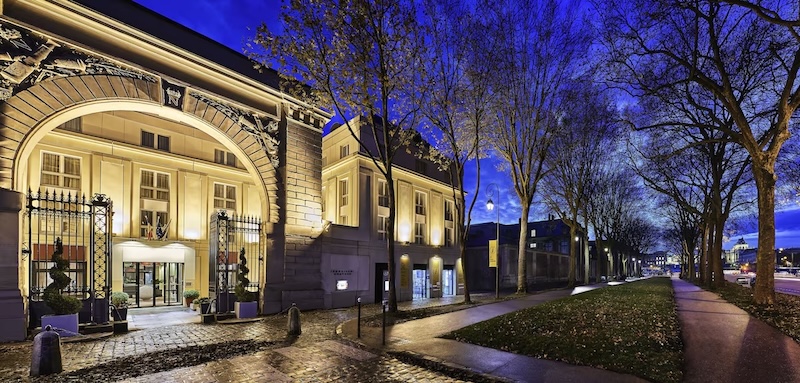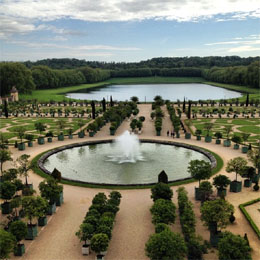Palace of Versailles history

Palace of Versailles history is associated with three French Kings. Sun King reigned from 1648 until 1715. He commissioned the Palace of Versailles and moved his court from Paris to Versailles in 1682. The representation of Versailles in 1668 by Pierre Patel, with the newly designed gardens by Le Notre and the older Louis XIII castle, helps us understand the work ordered by Sun King and accomplished in forty nine years, from 1661 until 1710, to build Versailles. Until his death in 1715, Versailles ruled France, then the most powerful kingdom of Europe. His successors, Louis XV and Louis XVI, lived in Versailles until 1789 when the revolution put an end to the royal history of the palace. Paris history.
Palace of Versailles history
Louis XIII, King of France since 1610, commissioned in 1623 a hunting lodge in the village of Versailles near Paris. His son, King Louis XIV, also named Sun King, who reigned 72 years from 1643 to 1715, commissioned in 1661, the design of the great Versailles Gardens.
Between 1668 and 1689, Architects Louis Le Vau and Jules Hardouin Mansard, his successor, substantially enlarged and embellished the Palace of Versailles. Gardener André Le Notre laid out the French style park starting in 1661. Charles Le Brun designed the paintings on the walls and ceilings and many of the park sculptures.
In 1685, 36,000 people and 6,000 horses were working on the construction of the 500 meter long palace. The royal chapel, designed by Jules Hardouin-Mansart, was consecrated in 1710. It took forty nine years altogether, from 1661 until 1710, to build the Palace of Versailles.
Read article on a day in the life of Louis XIV.

The Chapel was designed by Hardouin-Mansart
Hall of Mirrors history
Designed by architect Jules Hardouin-Mansart and decorated by painter Charles le Brun, the Hall of Mirrors was built between 1678 and 1684. It was first used as a passageway. It was also used on rare occasions for balls or games held for royal weddings or diplomatic receptions.
It was also the venue on January 18th 1871 of the proclamation of the German Empire (Deutsche Reichsgründung) by Otto van Bismarck, after the French defeat in the 1870 war, and of the 1919 signature of the Versailles treaty which ended WWI.

Sun King in Hall of Mirrors
Versailles Trianons history
Sun King commissioned the Grand Trianon in 1687 for his mistress, Madame de Montespan. Louis XV, Sun King's successor, commissionned the Petit Trianon in 1762. His successor, Louis XVI, offered it to his wife Marie Antoinette, Princess of Austria.
King Louis XVI, Queen Marie-Antoinette and the court abruptly left Versailles on October 6th 1789 at the outset of the French Revolution (read details). That was the end of the French monarchy in Versailles.

Grand Trianon was designed by Hardouin Mansart
Versailles Gardens history
The gardens are one of the jewels of Versailles. They were designed between 1661 and 1670 by Le Nôtre, the gardener of King Louis XIV, Sun King. The works took forty years to complete. Jean-Baptiste Colbert, Superintendent of the King’s Buildings, directed the project from 1664 to 1683.
Charles Le Brun, First Painter of the King, produced the drawings for many statues and fountains. The laying out of the gardens required enormous work. Vast amounts of earth were shifted for the flower beds, the fountains, the Canal. Spread with statues and fountains, the gardens were the setting of splendid royal parties until the 1789 revolution.

Sun King in Versailles Gardens
Sun King history
Louis XIV, France's Sun King, had the longest reign in European history (1643-1715). The King lived so long for the time that he was succeeded by his great grandson Louis XV.
During his reign, the King brought absolute monarchy to its height, established a glittering court at Versailles, and fought most of the other European countries in four wars. The early part of his reign (1643-61), while Louis was young, was dominated by the chief minister Cardinal Mazarin. In the middle period (1661-85), Louis reigned personally and innovatively, but the very last years of his personal rule (1685-1715) were beset by wars, cold winters and famine.
The legacy of this time includes some of the most remarkable monuments in France and a large part of the French classical literature with writers such as Moliere, Racine, Corneille and La Fontaine. The King had a special taste for the arts and detected the best artists of his time.

Sun King painted in 1701 by Hyacinthe Rigaud
Stay in top Versailles hotel

Versailles imitations history
The Palace of Versailles, including the famous Hall of Mirrors, has been imitated many times by monarchs in Europe during the 18th century. Schönbrunn in Vienna, Peterhof in Saint-Petersbourg and Caserte in Italy are the most famous imitations of Versailles.
The construction of Shönbrunn began in 1696. The formal gardens of the park were designed in 1695 by a student of Le Nôtre, Jean Tréhet. The park includes false Roman ruins and an orangery. The top of the park is occupied by the Gloriette, a neoclassical building from which there is a panoramic view of the castle and the city of Vienna.
It was after a trip to France that the Russian Tsar Pierre Le Grand decided in 1723 to build a palace inspired by that of Versailles. Right next to Saint-Petersburg, the Peterhof Palace and its sumptuous gardens proved that Versailles had definitely been able to export itself to very far.

Peterhof Palace in Russia imitates Versailles
Versailles visits
Open every day except on Mondays and 1 May. Opening times: 9.00am – 6.30pm. Last admission: 6.00pm. Ticket office closes at 5.50pm. Ticket price: 18 euros. Buy Versailles ticket. The gardens are open every day from 8.00am to 8.30pm Last admission: 7.00pm save exceptional weather (snow, violent winds...). The access is free except during Musical Fountains Shows and Musical Gardens. From Paris to Versailles, take the train at Gare Saint-Lazare to Versailles Rive Droite station or at Montparnasse to Versailles Chantier station (Count half an hour from Paris plus twenty minutes walk). Alternatively, discover the Palace of Versailles on a relaxing coach tour. Locate Versailles top sights on map of Versailles Palace and Gardens. Palace of Versailles interactive map.

Versailles Gardens were designed by Le Notre